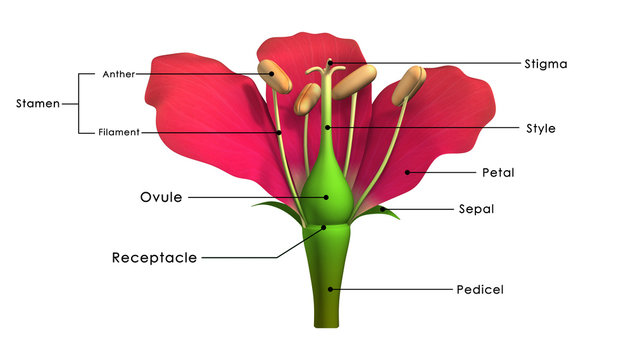Teacher name: Tasharni Bennett
Teacher Website: https://sites.google.com/stu.bmc.edu.jm/bennett/home
Welcome to our fascinating exploration of one of nature's most enchanting creations: The Flower.
The flower is the reproductive structure found in flowering plants (angiosperms). It is typically the most conspicuous part of the plant, often adorned with vibrant colors, enticing scents, and intricate shapes. Flowers serve the essential function of facilitating sexual reproduction by producing seeds.
The basic parts of a flower include:
Petal: Often brightly colored and scented, petals attract pollinators such as insects, birds, and bats.
Sepal: The sepals protect the flower in its bud stage and are often found beneath the petals.
Stamen: The male reproductive organ of the flower, consisting of an anther (which produces pollen) and a filament.
Pistil (or carpel): The female reproductive organ of the flower, typically comprising the stigma (where pollen lands), the style (a tube connecting the stigma to the ovary), and the ovary (which contains ovules, or unfertilized seeds).

When pollination occurs, pollen from the stamen is transferred to the stigma, initiating fertilization. The fertilized ovules develop into seeds within the ovary, and the ovary matures into a fruit.
Flowers come in an astonishing array of shapes, sizes, and forms, adapted to attract specific pollinators and thrive in diverse environments. They play a crucial role in ecosystems by supporting pollinators, providing food for animals, and contributing to the reproduction of countless plant species. Whether adorning gardens, forests, or fields, flowers captivate our senses and inspire wonder with their beauty and biological complexity.
Title: Botanical Sketch: Exploring Flower Anatomy
In this activity, students will engage in botanical sketching to explore the intricate anatomy of flowers and labelling the flower.
In this botanical sketching activity, students embark on an engaging journey to delve into the intricate world of flower anatomy. With pencils poised and paper ready, they begin by carefully selecting a fresh flower or using a picture as a reference. Armed with keen observation skills, they closely examine each part of the flower - from the delicate petals that unfurl like colorful ribbons to the protective sepals guarding the precious bud within.
With each stroke of the pencil, students capture the essence of the flower, striving to depict its unique characteristics with accuracy and detail. They meticulously sketch the graceful curves of the petals, the intricate patterns of the stamen, and the elegant form of the pistil. As they work, they label each part of the flower, reinforcing their understanding of botanical terminology and anatomy.
Through the act of sketching, students not only sharpen their artistic abilities but also deepen their scientific knowledge. They ponder the purpose of each flower part and contemplate how they work together in the miraculous process of pollination and reproduction. Their sketches become more than just drawings; they are windows into the fascinating world of plant biology.
As the teacher evaluating the flower sketches, I'd carefully look at each drawing to see if it matches a real flower. I'll check if they've drawn the right parts like the petals, leaves, and center. I'll also see if they've labeled everything correctly. I'll pay attention to the details and how well they've drawn them, like the shapes and colors. A grade will be given to the students.
After completing their botanical masterpieces, students take a moment to reflect on their observations and artistic choices. They share their sketches with classmates, discussing the similarities and differences among their interpretations. In this collaborative exchange, students gain new insights and appreciation for the diversity of flowers and their remarkable adaptations.
The diagram will be mark out of 50. 10marks each for Accuracy of Representation, Presentation, Detail and Observation, Artistic Expression and Reflection and Learning.
Teacher name: Tasharni Bennett
Teacher Website: https://sites.google.com/stu.bmc.edu.jm/bennett/home